+ Open data
Open data
- Basic information
Basic information
| Entry | Database: PDB / ID: 7um4 | |||||||||
|---|---|---|---|---|---|---|---|---|---|---|
| Title | Crystal structure of inactive 5-HT5AR in complex with AS2674723 | |||||||||
 Components Components |
| |||||||||
 Keywords Keywords | MEMBRANE PROTEIN / GPCR / inactive state / 5-HT5AR / HTR5A | |||||||||
| Function / homology |  Function and homology information Function and homology informationGi/o-coupled serotonin receptor activity / Serotonin receptors / serotonin receptor activity / G protein-coupled serotonin receptor activity / neurotransmitter receptor activity / postsynaptic specialization membrane / G protein-coupled receptor signaling pathway, coupled to cyclic nucleotide second messenger / adenylate cyclase-inhibiting serotonin receptor signaling pathway / hippocampus development / adenylate cyclase-activating G protein-coupled receptor signaling pathway ...Gi/o-coupled serotonin receptor activity / Serotonin receptors / serotonin receptor activity / G protein-coupled serotonin receptor activity / neurotransmitter receptor activity / postsynaptic specialization membrane / G protein-coupled receptor signaling pathway, coupled to cyclic nucleotide second messenger / adenylate cyclase-inhibiting serotonin receptor signaling pathway / hippocampus development / adenylate cyclase-activating G protein-coupled receptor signaling pathway / response to estradiol / G alpha (i) signalling events / perikaryon / chemical synaptic transmission / G protein-coupled receptor signaling pathway / dendrite / plasma membrane Similarity search - Function | |||||||||
| Biological species |  Homo sapiens (human) Homo sapiens (human) | |||||||||
| Method |  X-RAY DIFFRACTION / X-RAY DIFFRACTION /  SYNCHROTRON / SYNCHROTRON /  MOLECULAR REPLACEMENT / Resolution: 2.8 Å MOLECULAR REPLACEMENT / Resolution: 2.8 Å | |||||||||
 Authors Authors | Zhang, S. / Roth, B.L. | |||||||||
| Funding support |  United States, 2items United States, 2items
| |||||||||
 Citation Citation |  Journal: Nat Struct Mol Biol / Year: 2022 Journal: Nat Struct Mol Biol / Year: 2022Title: Inactive and active state structures template selective tools for the human 5-HT receptor. Authors: Shicheng Zhang / He Chen / Chengwei Zhang / Ying Yang / Petr Popov / Jing Liu / Brian E Krumm / Can Cao / Kuglae Kim / Yan Xiong / Vsevolod Katritch / Brian K Shoichet / Jian Jin / Jonathan ...Authors: Shicheng Zhang / He Chen / Chengwei Zhang / Ying Yang / Petr Popov / Jing Liu / Brian E Krumm / Can Cao / Kuglae Kim / Yan Xiong / Vsevolod Katritch / Brian K Shoichet / Jian Jin / Jonathan F Fay / Bryan L Roth /   Abstract: Serotonin receptors are important targets for established therapeutics and drug development as they are expressed throughout the human body and play key roles in cell signaling. There are 12 ...Serotonin receptors are important targets for established therapeutics and drug development as they are expressed throughout the human body and play key roles in cell signaling. There are 12 serotonergic G protein-coupled receptor members encoded in the human genome, of which the 5-hydroxytryptamine (5-HT) receptor (5-HTR) is the least understood and lacks selective tool compounds. Here, we report four high-resolution (2.73-2.80 Å) structures of human 5-HTRs, including an inactive state structure bound to an antagonist AS2674723 by crystallization and active state structures bound to a partial agonist lisuride and two full agonists, 5-carboxamidotryptamine (5-CT) and methylergometrine, by cryo-EM. Leveraging the new structures, we developed a highly selective and potent antagonist for 5-HTR. Collectively, these findings both enhance our understanding of this enigmatic receptor and provide a roadmap for structure-based drug discovery for 5-HTR. | |||||||||
| History |
|
- Structure visualization
Structure visualization
| Structure viewer | Molecule:  Molmil Molmil Jmol/JSmol Jmol/JSmol |
|---|
- Downloads & links
Downloads & links
- Download
Download
| PDBx/mmCIF format |  7um4.cif.gz 7um4.cif.gz | 108.4 KB | Display |  PDBx/mmCIF format PDBx/mmCIF format |
|---|---|---|---|---|
| PDB format |  pdb7um4.ent.gz pdb7um4.ent.gz | 78.3 KB | Display |  PDB format PDB format |
| PDBx/mmJSON format |  7um4.json.gz 7um4.json.gz | Tree view |  PDBx/mmJSON format PDBx/mmJSON format | |
| Others |  Other downloads Other downloads |
-Validation report
| Summary document |  7um4_validation.pdf.gz 7um4_validation.pdf.gz | 787.8 KB | Display |  wwPDB validaton report wwPDB validaton report |
|---|---|---|---|---|
| Full document |  7um4_full_validation.pdf.gz 7um4_full_validation.pdf.gz | 796.8 KB | Display | |
| Data in XML |  7um4_validation.xml.gz 7um4_validation.xml.gz | 18.7 KB | Display | |
| Data in CIF |  7um4_validation.cif.gz 7um4_validation.cif.gz | 24.9 KB | Display | |
| Arichive directory |  https://data.pdbj.org/pub/pdb/validation_reports/um/7um4 https://data.pdbj.org/pub/pdb/validation_reports/um/7um4 ftp://data.pdbj.org/pub/pdb/validation_reports/um/7um4 ftp://data.pdbj.org/pub/pdb/validation_reports/um/7um4 | HTTPS FTP |
-Related structure data
| Related structure data |  7um5C  7um6C  7um7C 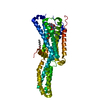 4iarS  4s0vS S: Starting model for refinement C: citing same article ( |
|---|---|
| Similar structure data | Similarity search - Function & homology  F&H Search F&H Search |
- Links
Links
- Assembly
Assembly
| Deposited unit | 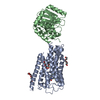
| ||||||||
|---|---|---|---|---|---|---|---|---|---|
| 1 |
| ||||||||
| Unit cell |
|
- Components
Components
-Protein , 2 types, 2 molecules AB
| #1: Protein | Mass: 38004.398 Da / Num. of mol.: 1 / Mutation: D65N, I278A Source method: isolated from a genetically manipulated source Source: (gene. exp.)  Homo sapiens (human) / Gene: HTR5A / Production host: Homo sapiens (human) / Gene: HTR5A / Production host:  |
|---|---|
| #2: Protein | Mass: 22251.660 Da / Num. of mol.: 1 Source method: isolated from a genetically manipulated source Source: (gene. exp.)  Homo sapiens (human) / Production host: Homo sapiens (human) / Production host:  |
-Non-polymers , 6 types, 15 molecules 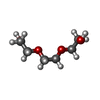
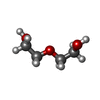
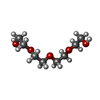
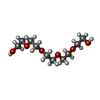
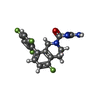






| #3: Chemical | ChemComp-PGE / | ||||||||
|---|---|---|---|---|---|---|---|---|---|
| #4: Chemical | | #5: Chemical | ChemComp-PG4 / | #6: Chemical | ChemComp-1PE / | #7: Chemical | ChemComp-NN6 / ~{ | #8: Water | ChemComp-HOH / | |
-Details
| Has ligand of interest | Y |
|---|---|
| Has protein modification | Y |
-Experimental details
-Experiment
| Experiment | Method:  X-RAY DIFFRACTION / Number of used crystals: 1 X-RAY DIFFRACTION / Number of used crystals: 1 |
|---|
- Sample preparation
Sample preparation
| Crystal | Density Matthews: 2.26 Å3/Da / Density % sol: 45.55 % |
|---|---|
| Crystal grow | Temperature: 293 K / Method: lipidic cubic phase Details: 0.1 M Sodium chloride, 0.1 M Lithium sulfate, 0.1 M DL-Malic acid pH 5.9, 30 % v/v PEG 400 |
-Data collection
| Diffraction | Mean temperature: 80 K / Serial crystal experiment: N | |||||||||||||||||||||||||||||||||||||||||||||||||||||||||||||||||||||||||||||||||||||||||||||||||||
|---|---|---|---|---|---|---|---|---|---|---|---|---|---|---|---|---|---|---|---|---|---|---|---|---|---|---|---|---|---|---|---|---|---|---|---|---|---|---|---|---|---|---|---|---|---|---|---|---|---|---|---|---|---|---|---|---|---|---|---|---|---|---|---|---|---|---|---|---|---|---|---|---|---|---|---|---|---|---|---|---|---|---|---|---|---|---|---|---|---|---|---|---|---|---|---|---|---|---|---|---|
| Diffraction source | Source:  SYNCHROTRON / Site: SYNCHROTRON / Site:  APS APS  / Beamline: 23-ID-D / Wavelength: 1.033 Å / Beamline: 23-ID-D / Wavelength: 1.033 Å | |||||||||||||||||||||||||||||||||||||||||||||||||||||||||||||||||||||||||||||||||||||||||||||||||||
| Detector | Type: DECTRIS PILATUS3 6M / Detector: PIXEL / Date: Aug 13, 2019 | |||||||||||||||||||||||||||||||||||||||||||||||||||||||||||||||||||||||||||||||||||||||||||||||||||
| Radiation | Protocol: SINGLE WAVELENGTH / Monochromatic (M) / Laue (L): M / Scattering type: x-ray | |||||||||||||||||||||||||||||||||||||||||||||||||||||||||||||||||||||||||||||||||||||||||||||||||||
| Radiation wavelength | Wavelength: 1.033 Å / Relative weight: 1 | |||||||||||||||||||||||||||||||||||||||||||||||||||||||||||||||||||||||||||||||||||||||||||||||||||
| Reflection | Resolution: 2.8→50 Å / Num. obs: 13732 / % possible obs: 99.2 % / Redundancy: 6.6 % / Biso Wilson estimate: 68.7 Å2 / Rmerge(I) obs: 0.307 / Rpim(I) all: 0.122 / Rrim(I) all: 0.332 / Χ2: 0.897 / Net I/σ(I): 5.8 | |||||||||||||||||||||||||||||||||||||||||||||||||||||||||||||||||||||||||||||||||||||||||||||||||||
| Reflection shell | Diffraction-ID: 1
|
- Processing
Processing
| Software |
| ||||||||||||||||||||||||||||||||||||||||||
|---|---|---|---|---|---|---|---|---|---|---|---|---|---|---|---|---|---|---|---|---|---|---|---|---|---|---|---|---|---|---|---|---|---|---|---|---|---|---|---|---|---|---|---|
| Refinement | Method to determine structure:  MOLECULAR REPLACEMENT MOLECULAR REPLACEMENTStarting model: 4S0V, 4IAR Resolution: 2.8→44.73 Å / SU ML: 0.46 / Cross valid method: THROUGHOUT / σ(F): 1.33 / Phase error: 31.13 / Stereochemistry target values: ML
| ||||||||||||||||||||||||||||||||||||||||||
| Solvent computation | Shrinkage radii: 0.9 Å / VDW probe radii: 1.11 Å / Solvent model: FLAT BULK SOLVENT MODEL | ||||||||||||||||||||||||||||||||||||||||||
| Displacement parameters | Biso max: 143.5 Å2 / Biso mean: 67.5536 Å2 / Biso min: 40.18 Å2 | ||||||||||||||||||||||||||||||||||||||||||
| Refinement step | Cycle: final / Resolution: 2.8→44.73 Å
| ||||||||||||||||||||||||||||||||||||||||||
| LS refinement shell | Refine-ID: X-RAY DIFFRACTION / Rfactor Rfree error: 0 / Total num. of bins used: 5
|
 Movie
Movie Controller
Controller






 PDBj
PDBj












